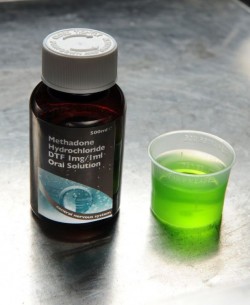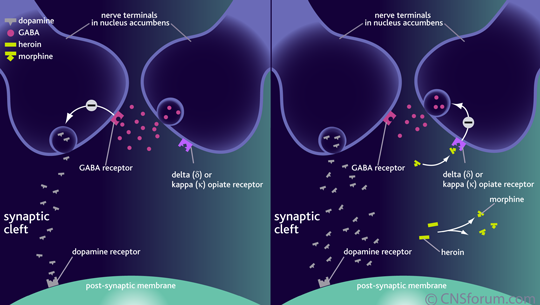Agonist drugs are those that bind to receptors, activating them to produce a biological response. In the case of opioids, the main targets are the u-opioid receptors in the brain which are activated when the opioid drug attaches to them. This opens up reward pathways in the brain resulting in the release of endorphins to reduce pain and produce senses of pleasure and relaxation.
According to the SAMHSA’s Center for Substance Abuse Treatment, “The synthetic opioids methadone and LAAM are the only long-acting full opioid agonists approved for opioid pharmacotherapy.” However, LAAM has, for the most part, been discontinued due to adverse effects.
What Are Endorphins?
Endorphins are naturally occurring chemicals known as neurotransmitters which can be produced to respond to certain stimuli by blocking them or signaling other neurological responses. The name is made up of two parts; endo-from within and orphin- from morphine, meaning morphine-like substances produced naturally in our bodies.
Neurotransmitters transmit electric signals from one neuron to another and interact with opioid receptors to control, activate, suppress, or help to regulate intricate biological responses throughout the brain, central nervous system (CNS), and the rest of the body.
An opioid agonist will have the same influences on the opioid receptors and their resulting endorphin responses with a high degree of intensity.
Dopamine
The neurotransmitter most influenced by opioids is dopamine. Dopamine naturally increases whenever we experience pleasure or satisfy a basic need such as eating, drinking fluids, or playing games. However, when opioids are used, dopamine can be increased far beyond the normal levels causing euphoria. Dopamine also acts to reinforce those behaviors that bear repeating and contributes to the development of opioid addictions when opioids are repeatedly used.
The Opioid Agonist, Methadone

Methadone is the most common opioid agonist.
Methadone is synthetic opioid agonist that is long acting and binds more slowly to the opioid receptors, but, essentially produces the same effects. It is the most notable opioid agonist used in the treatment of opioid addictions. Methadone has a half-life of 24 – 36 hours compared to other opioids which are much shorter.
Its agonistic effects block the effects of other opioids by occupying the opioid receptors and triggering the same neurotransmitter responses to reduce cravings, withdrawals, pain, and the associated behaviors of opioid addiction.
Because methadone can be stored in the blood until it is needed, it helps the person to stabilize chemical imbalances, improve health, and avoid the vicious cycles of intoxication and withdrawals that many opioid addicts go through several times a day.
What is an Opioid Agonist?
An opioid agonist is a chemical that produces similar effects to those produced by morphine and other opioids. Morphine, itself, is an agonist to the naturally occurring endorphins in our body that are released in response to stimuli such as pain and emotions.
The most commonly known full opioid agonist is methadone, a long acting synthetic opioid used in the treatment of pain and opioid addictions to reduce cravings and withdrawals.
How Do Opioid Agonists Work?
Opioid agonists bind to opioid receptor sites and activate them in, basically, the same way as other opioids, but, without all of the negative side effects.
Opioids essentially target u-opioid receptor sites in the brain and central nervous system. Once the opioids enter the receptor sites, a biological response occurs that causes the release of certain neurotransmitters to communicate signals from one neuron to the next. These neurotransmitters can either pass the signals along or block them while continuing to interact with the opioid receptors until the opioids are depleted, which is usually in a few short hours.
Opioid agonists, however, occupy these receptor sites for a longer period of time and continuously attaches to them, more slowly, and as needed. This prevents the need to repeat the cycles of opioid intoxication and withdrawals over and over daily and helps to stabilize the chemical imbalances that opioids, typically, cause.
Opioid Agonists Used for Detox from Opioids
Opioid addictions contribute to many adverse physical, psychological, and behavioral problems including the spread of diseases, unintentional overdoses, crime, unemployment, homelessness, and the deterioration of family units.
Opioid agonists such as methadone and the partial agonist, buprenorphine, are commonly used in opioid detox treatment programs to alleviate cravings and withdrawals while the person adapts to the cessation of opioid use.
Opioid Agonists Used for Medication Assisted Treatment for Opioid Addictions
According to the SAMHSA’s Center for Substance Abuse Treatment, “In general, the choice of medication used in medication-assisted treatment for opioid addiction (MAT) is based on safety and efficacy, patient preferences, and treatment goals.”
Methadone has a long history of effectiveness in the treatment of opioid addictions and is currently the only full opioid agonist available in the U.S. Methadone has been shown to control withdrawal symptoms, stabilize physiological processes, and improve functionality.
Bupreorphine was approved for opioid treatment therapy in 2002 and acts as a partial agonist to reduce withdrawals and cravings for opioids, without activating all of the opioid receptors as methadone does.
It, too, works slowly and can minimize the ups and downs of opioid addictions allowing for the stabilization of physiological processes. Buprenorphine is the first partial opioid agonist to be made available by physicians without the burden of daily visits to a clinic.









